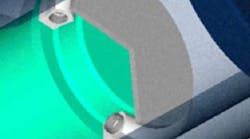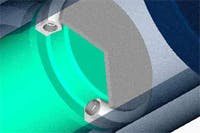Tandem seal prevents pressure buildup
Tandem rod seals present a great way to keep fluid sealed within a hydraulic cylinder while keeping contaminants out. However, pressure can sometimes build up in the cavity between the seals, which can cause premature wear and leakage. To overcome this problem, Trelleborg Sealing Solutions, Fort Wayne, Ind., has introduced the Turcon Stepseal V, which is designed to prevent pressure from being trapped in even the most difficult arrangements.
Joe Jakubowski, of Trelleborg, explains that the Turcon Stepseal V addresses the specific issue of pressure buildup in some tandem seal arrangements. “In these situations it provides significantly extended life and a superior overall performance (over conventional seal designs).”
The Turcon Stepseal V incorporates a hydrostatic pressure relief system, which provides rapid pressure actuation and pressure balancing under all service conditions. A machined valve groove ensures precise opening and closing of the relief channel, providing effective pressure relief independent of hardware deflection.
The inherent low friction and high wear and abrasion resistance of Turcon, Trelleborg’s proprietary PTFE-based material is enhanced by the Stepseal V’s contoured rear chamfer for hydrodynamic back-pumping. In back-pumping technology, an oil-lubricating film is distributed under the seal when the piston rod extends. When the rod retracts, the oil is pumped back into the cylinder, preventing extending leakage and reducing dynamic friction and breakaway force — even after extended periods of rest..
Designed for operation at temperatures from -45° to 200° C (–49° to 392° F), the Turcon Stepseal V is suitable for static applications, but is designed especially for dynamic applications. It operates at speeds to 15 m/s (49 ft/sec) with reciprocating frequencies to 5 Hz and pressures to 80 MPa/ 800 bar/ 11,600 psi. Because it is PTFE based, it is compatible with most common hydraulic fluids, such as mineral oil based, fire resistant, environmentally-safe fluids (bio-oils) and water based fluids.
Because of the Turcon Stepseal V’s design, it does not need buffer volume between inboard and outboard elements, saving both cost and space. The seal is easy to install, and its design has a stabilizing edge that prevents seal deformation and increases assembly robustness by protecting the seal face during rod insertion. It can be fitted in bore diameters to 2700 mm (8 ft 10 in.) and rod diameters to 2600 mm (8 ft 6 in.). It also has high resistance to extrusion, so it suits wide hardware clearances.


